Mastering the Waves: Expert Tips for Ocean Navigation
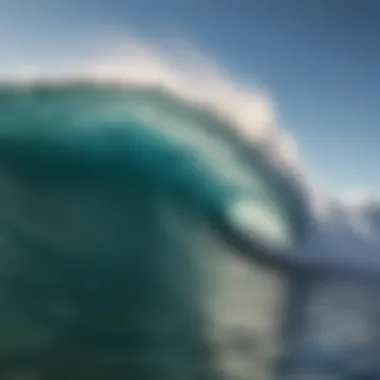
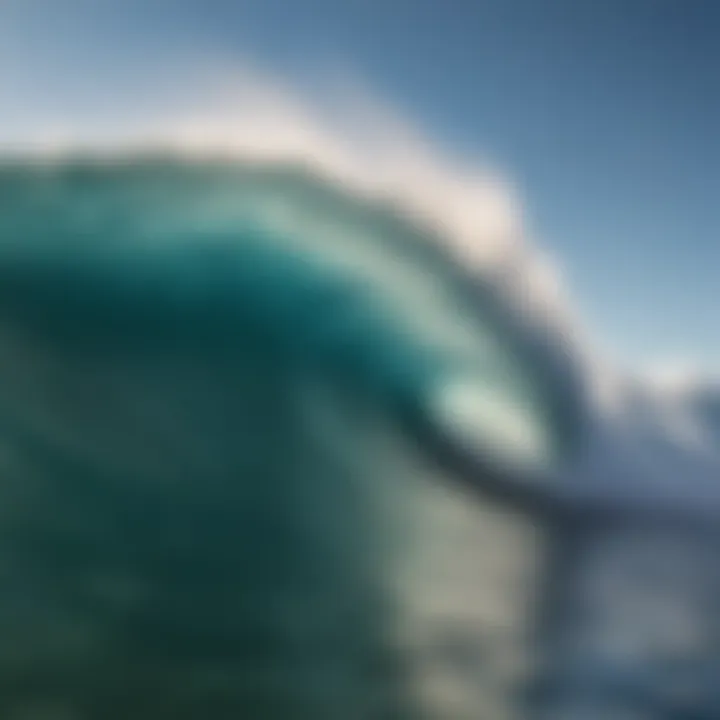
Intro
Navigating ocean waves can feel like a dance with nature, a dance that requires not only skill but a deep understanding of the environment. For many, it’s not just about catching a wave but harmonizing with the rhythm of the sea. This guide will dive into the essentials of gear, techniques, and tips to help you become proficient in this thrilling pursuit.
Riding the waves is an art that brings together enthusiasts from all over, whether they are surfers, paddleboarders, or kite surfers. Knowing how to read the ocean and employing the right equipment can make all the difference. As you embark on this journey, consider the following insights that may illuminate your path.
Gear Essentials
Understanding your equipment is crucial when it comes to mastering wave navigation. Not only can fresh gear enhance your performance, but proper maintenance is also pivotal in ensuring safety and longevity.
Top Picks for Watersports Equipment
When selecting gear, focus on what suits your style and the type of wave conditions you’ll be facing. Here are some well-regarded options:
- Surfboards: For surfers, the size and shape of the board matter. A shortboard offers speed and maneuverability, while a longboard provides stability for bigger waves.
- Paddleboards: Choose a stable paddleboard for flat water and a more agile one for ocean conditions. Brands like Starboard and Naish are popular for their durable and versatile designs.
- Kite-surfing Gear: Look for kites that match your skill level and the wind conditions. The North Reach is often favored for its versatility across varying winds.
Maintenance and Care Tips for Gear
Taking care of your equipment is just as important as selecting the right gear. Here are some tips to keep in mind:
- Dry Everything: After each use, ensure your gear is properly rinsed off with freshwater. Salt can degrade equipment over time.
- Check for Damages: Regularly inspect for any wear and tear. Minor repairs can prevent bigger accidents.
- Store Safely: When not in use, keep your gear in a cool, dry place out of direct sunlight to prevent material degradation.
Techniques and Tips
Enhancing your skills is an ongoing journey. Both beginners and advanced water sport enthusiasts can refine their techniques with practice and the right advice.
Beginner Tips for Each Watersport
For those just starting, grasp these key approaches:
- Surfing: Paddle out at an angle to the waves and practice popping up on the board on dry land before attempting it on the water.
- Paddleboarding: Maintain an athletic stance, keeping your feet shoulder-width apart, and use your core for balance while paddling.
- Kite-surfing: Start by understanding how to control the kite on land before venturing out, ensuring you can manage its pull.
Advanced Techniques for Skill Enhancement
Those looking to up their game should consider:
- Reading Waves: Learn how to observe and interpret the ocean’s patterns. This skill can lead to confident decisions about when to catch a wave or ride it down.
- Trick Progression: Once you feel steady, try small tricks like shuv-its on your board to add flair.
"Mastery does not come overnight; it requires time, patience, and a lot of practice."
In summary, the ocean is a dynamic entity that deserves respect and understanding. With the right gear and techniques, you can master the art of navigating its waves. Embrace every moment, practice safety, and, most importantly, enjoy the ride.
Prelims to Ocean Waves
Understanding ocean waves is paramount for anyone venturing into watersports, whether you’re surfing, paddleboarding, or kitesurfing. Waves are not just random undulations of the ocean; they are a complex interplay of various environmental factors.
For starters, grasping the nuances of wave behavior can significantly enhance performance and safety out on the water. Imagine paddling out only to find yourself overwhelmed by an unexpected set of waves—knowing the details of what causes these conditions can mean the difference between a thrilling ride or a treacherous experience.
Understanding Wave Formation
The role of wind
The wind serves as the primary architect of wave development. It’s the squall that drives the surface of the water, creating energy that formulates waves. Wind speed and duration profoundly impact wave size and frequency. A light breeze may only generate small ripples, whereas a sustained gale can lead to towering waves.
When the wind blows consistently over a vast expanse of water, waves build in power and size. This characteristic is essential for surfers, as knowing how to read wind patterns enables one to predict optimal riding conditions. However, strong winds can also create challenging conditions, making the ocean seem like a wild beast, which is something any water enthusiast has to be ready for.
Influence of geography
Geographical features play a crucial role in shaping the behavior of ocean waves. Coastlines, reefs, and other structures influence how waves break and interact with the shoreline. For example, a beach with a gradual slope might see smaller, more manageable waves, while steep rocky cliffs can lead to powerful breaks that challenge even the most skilled riders.
This makes it essential for surfers and other watersport participants to familiarize themselves with local geography. Knowing where to find the best waves or the safest spots to ride can help avoid dangerous situations and enhance the overall experience.
Weather patterns and their effects
Finally, weather patterns can have dramatic impacts on wave conditions. Storms can generate swell far away, sending ripples out across the ocean that may manifest as sizeable waves upon reaching the coast. Seasonal changes, like monsoon seasons, can likewise alter wave behavior.
It’s key for anyone engaged in a watersport to stay updated on local weather forecasts and understand how different patterns affect wave activity. A sudden change can shift the tide, altering wave sizes and unpredictability, and is a factor that needs consideration well before hitting the water.
Types of Ocean Waves
Understanding the different types of ocean waves is essential for anyone looking to improve their skills on the water, as it helps determine the best technique and gear to use.
Monsoonal waves
Monsoonal waves are powerful and usually occur during specific seasonal weather transitions. They can create long periods of consistent swells that draw surfers from various places looking for those prime riding conditions. Not only can these waves be exhilarating, but they often come with a more predictable rhythm, allowing riders to prepare better for the experience.
However, the strength of these monsoonal waves can be intimidating. Riders need to be in tune with their equipment and be skilled enough to navigate the massive surges effectively.
Swells and their characteristics
Swells represent a type of wave that has traveled far from where they were generated, taking on a smoother and more powerful shape as they approach the shore. Characteristics of swells vary based on their origin—fetch, wind speed, and duration all contribute to their unique profiles.
Riders often seek out these swells because they provide excellent conditions for surfing. Prioritizing swells allows watersport participants to enjoy dynamic rides, but they also require an understanding of how to adjust to their unique patterns. This knowledge is crucial for harnessing the power of swells for the best possible experience on the water.
Choppy conditions
Choppy conditions arise from varying wind currents, often leading to unpredictable and short bursts of wave energy. Though they can pose challenges for many riders, they can also offer unique thrills for those who know how to tackle them. Navigating through choppy waves involves agility and adaptability; using quick reactions can keep a rider upright and moving forward.
However, it’s essential to recognize that choppy conditions can lead to a lack of control, making it necessary for riders to be cautious. Knowing how to read and react to these rough patches can make all the difference in enjoying your time on the water, all while ensuring safety.
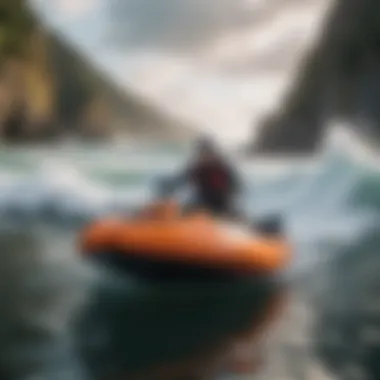
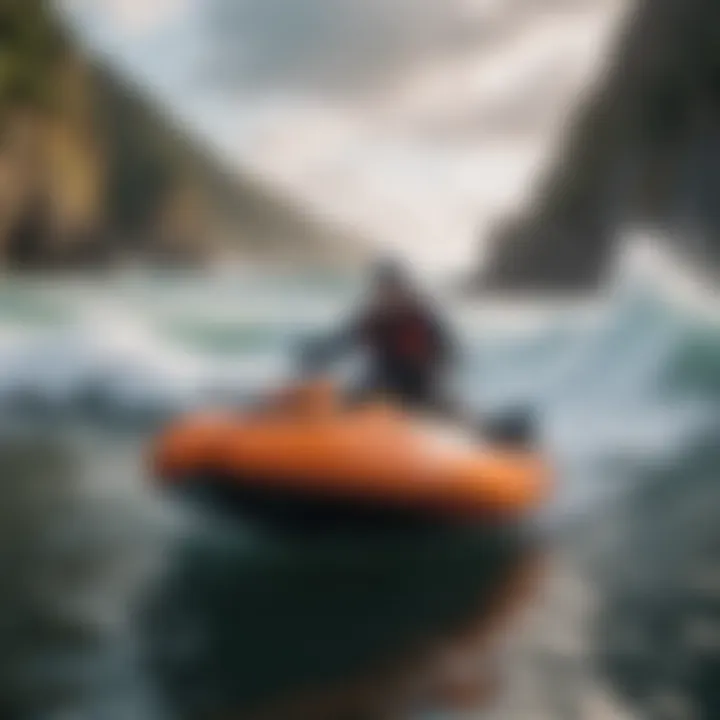
The Importance of Reading Waves
Understanding and interpreting wave behavior is fundamental for anyone navigating ocean waters. The ocean isn’t merely a vast expanse of water; it’s a dynamic environment where each wave carries not just energy but also potential risks and thrills. Reading waves correctly can enhance both the enjoyment and safety of your time on the water. Navigating through waves without grasping their behavior is like sailing a ship with no compass.
Analyzing Wave Behavior
Analyzing how waves behave provides essential insights that can influence the surfing or coastal recreation experience. Recognizing subtle changes in wave dynamics can often mean the difference between a thrilling ride and a dangerous encounter.
Identifying break points
Break points refer to areas where the wave reaches a shallow depth and begins to crest, eventually crashing. An adept surfer knows that identifying these points is crucial for successful wave riding. Recognizing a break point is not just about catching a wave; it’s about maximizing the ride while minimizing potential wipeouts.
Identifying these spots takes practice, and the right attributes—like a keen eye for changing wave patterns—set experienced surfers apart from novices. Understanding where waves break also aids in positioning oneself to catch them more effectively, adding to the overall experience.
One unique feature of break points is that they can vary significantly depending on the tide and weather. This variability can be an advantage or a disadvantage. For someone well versed in reading waves, it offers opportunities to choose the best spots for riding. However, for less experienced surfers, it can feel like navigating a minefield.
Recognizing wave sets
Wave sets consist of groups of waves that come in series, and recognizing these sets plays a vital role in effective wave riding. Surfers who can anticipate when a set will arrive can position themselves better and plan their maneuvers accordingly.
The key characteristic of recognizing these sets is regularity. Experienced surfers often notice patterns in swell; some sets may be powerful and spaced out, while others could be peaky with minimal gaps. This knowledge is a powerful ally in planning when to paddle out and when to ride.
However, unfamiliarity with local wave sets can be a double-edged sword. While the excitement of discovery is undeniable, it also poses a risk when miscalculated sets lead to missed opportunities or even dangerous conditions, particularly for inexperienced surfers.
Understanding rip currents
Rip currents are strong, narrow channels of fast-moving water that flow away from the shore. Recognizing these currents is crucial for safety; getting caught in one can be a perilous situation. Their powerful nature can shift quickly and often without warning. Knowing how to identify the tell-tale signs of rip currents adds a vital layer of safety to wave activities.
The unique feature of rip currents is that they can sometimes look deceptively calm or may not present any visible turbulence, making it tricky to spot them. Understanding where they frequently occur gives savvy surfers an edge, allowing them to avoid these sections or use them to their advantage, rescuing themselves from a tiring paddle back to shore.
However, it’s critical to approach rip currents with respect. While they pose risks, they can also be navigated safely with knowledge. A good grasp of how these currents operate could transform a potential danger into an opportunity, provided you know what to do when caught in one.
Predicting Ocean Conditions
Being able to predict ocean conditions is another crucial aspect of navigating waves effectively. With the right knowledge, conditions that appear daunting can be managed.
Using surf reports
Surf reports are indispensable tools for predicting wave conditions. They compile and present vital information on wave height, wind direction, and current conditions, which inform your decisions on when and where to surf. Experienced surfers swear by them, finding that they often dictate the day’s plans or even trips.
The key characteristic here is updates; reliable surf reports are typically provided by various platforms and can change throughout the day. This real-time insight into ocean conditions can mean the difference between a wasted trip and an exhilarating day on the water.
Surf reports usually come with advantages, too. They provide forecasts that factor in local weather and tide conditions, helping surfers make informed decisions. However, reliance on inaccurate reports can lead to disappointment or dangerous situations, making critical assessment of sources necessary.
Impact of lunar phases
The lunar phases influence wave patterns in nuanced ways, making it another critical element for wave reading. The gravitational pull of the moon affects tides, which in turn impacts how waves form and break. Understanding this relationship means adjustments in surfing plans can be made based on whether you are working with high or low tides.
This aspect of navigation enhances predictive capabilities and is often overlooked. While it may seem trivial, knowing when a full moon occurs could change a surf session from average to extraordinary with the right swells.
However, aligning surf sessions solely with lunar cycles can be tricky; it’s just one factor among many, and not every surfer pays attention to these nuances.
Seasonal variations
The ocean is ever-changing, and seasonal variations provide another key element in understanding wave patterns and conditions. Different seasons bring disparate wave characteristics. For example, winter months often bring more consistent swells, while summer might yield smaller, more playful waves.
The significance here lies in adapting strategies. Knowledge of seasonal variations means surfers can plan trips to specific locations at optimum times.
Nonetheless, this understanding is a learning curve, particularly for newcomers who may have initial excitement tempered by chasing waves in the wrong seasons. Familiarizing oneself with seasonal shifts can enhance not just skill but enjoyment in navigating the water.
Essential Gear for Wave Riding
When engaged in ocean sports, having the proper gear is not merely a choice; it’s an absolute necessity. Just like a carpenter wouldn’t be caught dead with dull tools, a wave rider needs the right equipment to tackle the fickle nature of the sea. Good gear not only enhances performance but also ensures safety, making it paramount for both novices and seasoned surfers alike.
By choosing the right gear, enthusiasts can maximize their enjoyment, boost their skill level, and perhaps most importantly, stay safe in unpredictable conditions. Each piece of equipment plays a role in navigating the ocean’s whims, which can otherwise lead to unnecessary risks.
Choosing the Right Board
Types of surfboards
Diving into types of surfboards is like walking into an ice cream parlor; there’s an option for everyone, but knowing what suits your taste is crucial. Here we look at two prevalent forms: shortboards and longboards.
- Shortboards are favored for their agility. Perfect for high-performance surfing, they make quick turns possible.
- Longboards, on the other hand, excel in stability and easy paddling, making them advantageous for beginners who need to build their confidence.
Both have their unique characteristics. Shortboards are well-suited for average to advanced surfers looking to catch aggressive waves, whereas longboards favor a smoother glide and can be a comfortable ride for both beginners and those who prefer cruising the waves. In the end, that right board is the one that fits your style and skill level.
Considerations for paddleboards
When it comes to paddleboards, there are various elements worth noting. Their buoyancy and stability make them appealing. Generally, these boards offer a larger surface area, which promotes balance, pushing beginners to feel a little less like a fish out of water.
The standout feature of most paddleboards is that they can be used for both leisurely paddling and vigorous workouts. That versatility is attractive, especially for those who enjoy a variety of activities on the water. However, they tend to be heavier than surfboards, which may require extra muscle for transport.
Kiteboarding equipment essentials
Kiteboarding presents its unique blend of thrill, charm, and the perfect equipment mix. Central to this sport are the kite and the board. Both must align with the rider’s skill and desired experience.
Kite sizes greatly influence the kind of ride you'll have; smaller kites are suited for stronger winds while larger kites offer more lift in lighter winds. This can be beneficial for those looking to catch air or ride in varied wind conditions.
However, kiteboarding equipment does come with some drawbacks; the learning curve can be steep, and not everyone becomes comfortable with the technical aspects quickly. Nonetheless, the adrenaline rush makes it worth the effort for many.
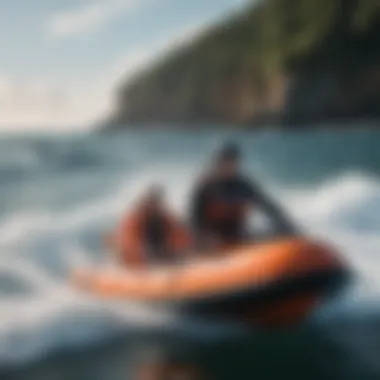
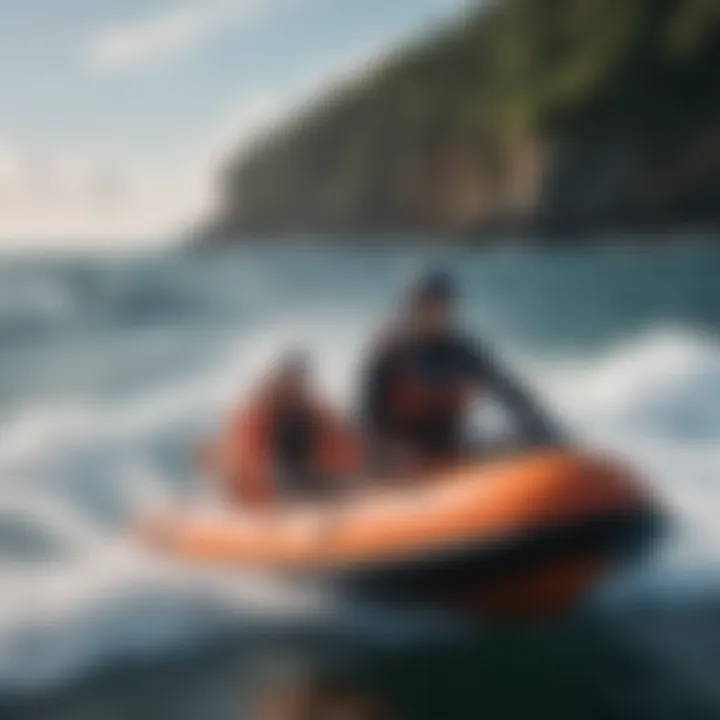
Safety Equipment
Life vests
Safety gear is the cornerstone of any water sports experience. Life vests are an evident choice here. They are designed not just to keep you afloat but offer additional safety measures and peace of mind.
A good life vest is streamlined and snug, allowing for freedom of movement while still providing buoyancy. Some models even have pockets for essentials, making it a handy option for surfers to carry small items without weighing them down. However, ensuring a proper fit is critical; a vest that's too loose may not provide adequate safety during a sudden wipeout.
Wetsuits and thermal gear
Warmth is a paramount concern when surfing in cooler waters, thus investing in a wetsuit can be a game-changer. The key feature of a wetsuit is its insulation, offering protection against chilly conditions allowing you to ride longer.
However, it’s worth remembering that wetsuits come in various thicknesses. Choosing one that fits your surfing style and local conditions is crucial. Opting for a suit that is too thick might hinder movement while a thin one could leave you shivering out there in the waves.
Communication devices for safety
Lastly, communication devices add a layer of security. Relying solely on visible signals may not always be practical in the ocean’s swells. Waterproof phones or radios can keep you connected with your companions.
Featuring functionalities like GPS tracking, many models enhance safety measures, guiding rescuers if needed. It’s a small investment for potentially life-saving technology. But remember to keep the gear secure, as well; losing it to the ocean may turn a safety asset into a liability.
The right gear equips you for success, ensuring that enjoyable spy on the waves stays colorful and thrilling while maintaining safety as a priority.
Techniques for Riding Waves
Understanding Techniques for Riding Waves is fundamental for anyone serious about various watersports. Whether you’re surfing, paddleboarding, or kitesurfing, your success largely hinges on mastering specific maneuvers tailored for ocean conditions. This section will delve into strategies that enhance performance, boost confidence, and ultimately, elevate your riding experience. Your ability to navigate effectively through the waves can mean the difference between a smooth ride and a harrowing tumble.
Body Positioning
Optimal stance
Taking the right stance can make a world of difference in your wave-riding game. An optimal stance ensures stability and control as you ride down the face of the wave. Typically, this stance involves keeping your feet shoulder-width apart with your knees slightly bent. This not only helps maintain balance but also allows for quick adjustments when necessary.
The key characteristic of an optimal stance is its versatility; it adapts to various types of waves. It’s a popular choice for beginners and advanced surfers alike because it provides a solid foundation for other techniques like turning and paddling.
However, one challenge can be learning to maintain that stance while navigating through different wave patterns that may require adjustments in foot placement or body lean.
Weight distribution
Another pivotal aspect of mastering waves is Weight distribution. Proper weight distribution helps control your board and ensures better responsiveness to the water’s flow. Ideally, you want your weight centered between your feet, allowing for fluid movement back and forth on the board. Getting this right can make waves feel more in sync with your movements, enhancing your riding experience.
This technique is particularly beneficial because it reduces the chances of nosediving or wiping out during unexpected choppy conditions. On the flip side, overcompensating with your weight toward the tail can hinder your control on steeper waves, making precision turning challenging.
Adjusting to wave type
Adjusting to wave type is crucial for every wave rider—be it during a surfing session or a kitesurfing adventure. Different waves demand distinct strategies. For instance, when facing a steep, fast wave, leaning forward can help maintain speed and prepare for take-off. Conversely, with slower, rolling waves, a more relaxed posture can keep you positioned for smooth transitions.
The beauty of this technique lies in its adaptability. It pushes riders to constantly assess and integrate their body position with the immediate environment. However, failure to quickly adapt can lead to serious miscalculations, where a wave catches a rider off guard, potentially resulting in falls.
Paddling Techniques
Efficient paddling strategies
Effective paddling is not just about powering through the water but doing so with finesse. Efficient paddling strategies focus on maximizing your effort while minimizing energy expenditure. This involves long, smooth strokes rather than frantic, short ones. By engaging your core and using your arms effectively, you can maintain momentum and position yourself better to catch waves.
What sets this technique apart is its emphasis on flow rather than sheer strength. It’s beneficial for all types of wave activities, especially for longer sessions where stamina is crucial. On the downside, mastering this can take practice, and improper technique may lead to exhaustion or even injury over time.
Timing your take-off
Mastering the art of Timing your take-off is often what separates the novices from the pros. Knowing when to commit and stand up on your board can dictate whether you ride gracefully or tumble into the surf. The key is reading the wave—a rider must sense when the wave is building and get onto their feet just before it peaks.
This technique is beneficial, as it can lead to smoother entries and better momentum down the line. Yet, timing is tricky; misjudging even a split second can result in a wipeout, dampening your riding experience.
Using leg power
Lastly, Using leg power efficiently can transform your wave-riding capabilities. Your legs play a crucial role in generating speed and controlling turns. Engaging the muscles in your legs helps power through your strokes and maintain balance during waves. For instance, using your legs to push off in a take-off boosts both speed and stability.
One unique feature of this technique is how it encourages better board control, especially in more dynamic conditions. However, over-using leg power without proper rhythm can lead to fatigue—working smarter, not just harder, is the key.
Turning and Maneuvering
Carving techniques
Carving techniques refer to the stylish way riders handle turns on the water, allowing for smoother transitions and greater control. This technique involves a specific foot placement that lets riders shift their weight from toe to heel seamlessly, creating a curved path rather than sharp changes in direction. This not only enhances speed but also gives your riding a fluid, graceful feel.
The beauty of carving lies in its efficiency; it conserves energy while maximizing speed, making it a favorite among many serious wave riders. Yet, figuring out the perfect balance can take time, and making wide turns can sometimes lead to sluggishness if not executed correctly.
Quick turns in choppy waters
Performing Quick turns in choppy waters can be a game-changer on a chaotic surf day. This technique emphasizes speed and agility, allowing you to navigate through unpredictable swells. It requires quick footwork and rapid body adjustments to maintain balance while turning sharply.
The main advantage here is the ability to avoid obstacles and manage unexpected wave shifts efficiently. However, the downside might be the risk of losing control if executed improperly—often leading to wipeouts or disorientation.
Maintaining speed through turns
Finally, Maintaining speed through turns is essential for any rider wanting to keep up the momentum. It involves making subtle adjustments in weight distribution and using your legs for propulsion while turning. This technique not only helps in executing tighter turns but also allows for smoother transitions back into riding.
The unique feature of this skill is that it keeps your speed consistent, ensuring that you navigate through sets effectively. On the other hand, over-committing to a turn can lead to losing speed entirely, leaving a rider vulnerable to falling back into the surf.
Mastering these techniques is critical in developing your skills and confidence on the water. As you practice these maneuvering strategies, you'll find your connection with the ocean deepening, making each wave a new adventure.
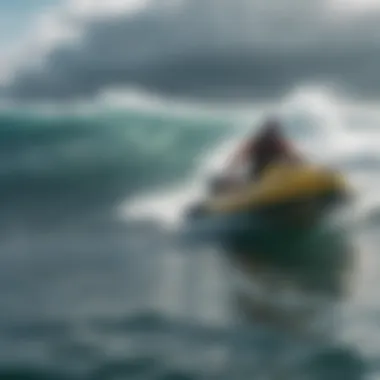
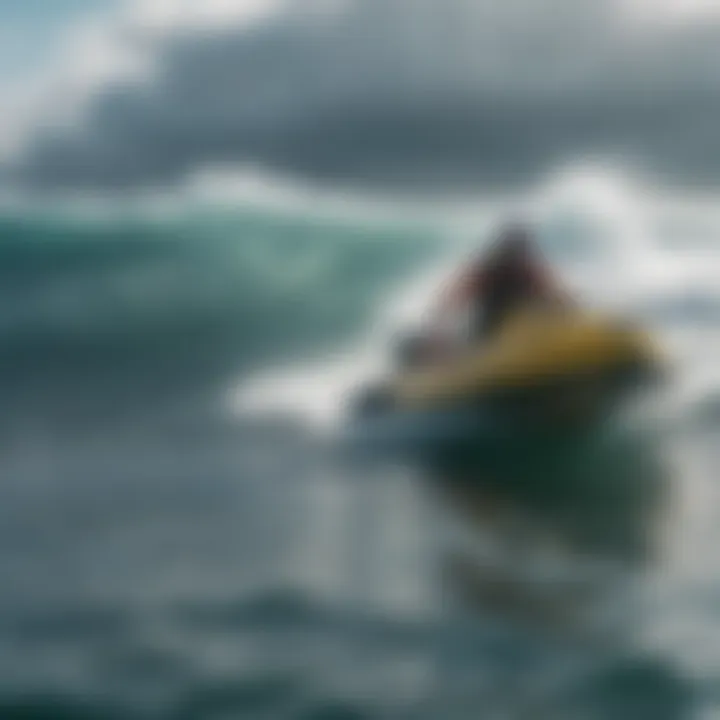
Environmental Considerations
Understanding the intricate relationship between ocean waves and the environment is crucial for anyone engaging in water sports. Every time a board hits the surf, it's not just about thrill—it's about the impacts we have on marine ecosystems and the safety practices we need to adopt. As surfers, paddleboarders, and kitesurfers, being mindful of environmental considerations allows us to enjoy our passions while safeguarding the beauty of Mother Ocean.
Marine Life Awareness
Understanding local species
Knowledge of local marine species is essential for anyone navigating ocean waves. Not only does it enhance the surfing experience, but it also contributes to the overall safety of water sports enthusiasts. Each region has its own set of species, some of which are harmless, while others can pose dangers. Knowing what lurks beneath the surface can help practitioners respect the ecosystem and enjoy a seamless ride.
For instance, recognizing that certain areas host jellyfish during specific months can make a world of difference in avoiding stings. Similarly, being aware of local fish species can support conservation efforts and encourage sustainable practices. Understanding these nuances can transform a casual surfer into an educated participant of the ocean community.
Avoiding dangerous encounters
Navigating ocean waves also involves being prepared for encounters with marine life. Understanding what species to avoid and how to react in sudden situations can save you from potentially dangerous scenarios. This knowledge not only helps keep surfers safe but also supports marine conservation, promoting respectful interactions with wildlife.
Certain animals, like sharks, often get a bad rap. Most species are not aggressive toward humans unless provoked. Familiarizing oneself with safety practices ensures that interactions are not only safe but beneficial, aiding in a greater respect for these creatures. As watersport enthusiasts, it is our duty to navigate thoughtfully and promote safety in our aquatic adventures.
Conservation considerations
Another vital aspect of marine awareness is conservation. Understanding the impact of our actions on the ocean plays a significant role in ensuring it remains vibrant for future generations. From ensuring trash is disposed of properly to minimizing disturbances to nesting sites, every little bit helps maintain the delicate balance of oceanic life.
Increased awareness about conservation contributes to a culture of respect and responsibility among watersport practitioners. By engaging in local conservation efforts, we not only safeguard marine habitats, but also deepen our connection with the ocean. This collective effort is not just good for marine life but also enriches our experiences in the water.
Respecting Beach Etiquette
Etiquette plays a crucial role when enjoying the waves. It's not just about riding waves; it's about respecting the community that shares these spaces. Following proper beach etiquette can enhance the surfing culture and create a more enjoyable environment for everyone involved.
Right of way rules
Understanding right of way rules is fundamental in maintaining harmony in the surf. These guidelines dictate who has priority on a wave, aiming to minimize conflicts in crowded waters. Not adhering to these rules can lead to unsafe scenarios and negative experiences.
Surfers need to communicate and be aware of who is closest to the wave's peak. This behavior fosters a sense of mutual respect and ultimately leads to a more enjoyable experience for all. Knowing when to yield and when to ride ensures that everyone gets a chance to enjoy the waves.
Minimizing environmental impact
Minimizing environmental impact is a shared responsibility of each water sports enthusiast. From carrying reusable water bottles to using eco-friendly products like wax, every small decision contributes to protecting our oceans. Engaging in practices that have minimal ecological footprints demonstrates respect for the environments we cherish.
By being mindful about our equipment choices and the waste we produce, we can ensure that our beloved beaches and waterways remain pristine for generations. Sharing knowledge of these practices within communities can inspire collective action, making a significant difference.
Engaging with the local community
Lastly, engaging with the local community is critical. Forming bonds with other practitioners fosters a culture of shared knowledge that benefits new and seasoned surfers alike. Local clubs, forums, and meetups offer opportunities to learn about waves, local conditions, and environment-friendly practices.
Participating in local events promotes unity among water sports enthusiasts, encouraging a collective existential tie to the ocean. This involvement can lead to a deeper understanding of local ecosystems and initiate conversations on how to protect them effectively. The vibrancy of surfing culture thrives when we support each other and the world we share.
"Take care of the ocean, and she will take care of you."
By being conscious of environmental considerations, water sports enthusiasts can cultivate a deeper connection with nature, ensuring the preservation of the ocean's wonders while enjoying the thrill of riding waves.
Closure and Future Perspectives
Navigating the ever-changing dynamics of ocean waves is not just an art, it’s a journey that requires continuous growth and adaptation. As we wrap up our exploration of mastering wave riding, it becomes clear why future perspectives in this field are crucial. Engaging with the community, advancing personal skills, and respecting the environment ultimately shape a surfer’s journey.
As we move forward in the watersport landscape, it’s vital to emphasize the learning processes that never really stop. The ocean remains unpredictable, often presenting new challenges that require experienced sailors and beginners alike to stay sharp in their skills. Embracing continuous learning not only enhances proficiency but strengthens the bond with fellow watersport enthusiasts.
Continuous Learning in Watersports
Joining Local Surf Schools
Joining local surf schools stands out as one of the most practical ways to learn the nuances of wave riding. These schools often offer structured learning environments, where instructors can share their insights and personal experiences. What sets these schools apart is their tailored approach; they assess individual needs and capabilities before offering guidance.
The benefits of enrolling in a surf school are manifold. Access to experienced instructors introduces novice surfers to foundational techniques quickly. Additionally, surf schools tend to foster a community spirit, where connections thrive, leading to potential friendships both in and out of the water. Although some may find the cost of lessons to be a drawback, the investment can pale in comparison to the wisdom gained through direct, hands-on guidance.
Attending Workshops and Seminars
Workshops and seminars provide an essential platform for surf enthusiasts keen to expand their knowledge beyond just riding techniques. These gatherings often feature expert speakers who delve into various aspects of watersports, including equipment advancements, environmental concerns, or fitness for surfing. This avenue’s standout characteristic is the exposure to diverse perspectives, helping individuals to better strategize their approach to wave riding.
Participating in such events offers attendees a unique chance to network, ask pressing questions, and learn from one another. However, one should note that not all workshops might align perfectly with specific interests, which can sometimes make it challenging to find value. Despite this, the potential benefits are significant, especially in fostering innovation and fresh ideas in wave navigation practices.
Online Resources and Forums
In today's digital world, online resources and forums have emerged as treasure troves of knowledge for aspiring and seasoned watersport practitioners. These platforms enable individuals to communicate across distances, share experiences, strategies, and even gear recommendations specifically tailored for various ocean conditions. The collaborative nature of these forums drives engagement, leading to a wealth of information that’s both current and applicable.
The beauty of utilizing online resources is that knowledge is often available 24/7, allowing users to gain insights at their own pace. Social media platforms and dedicated websites create spaces for discussions that might not be easily accessible otherwise. One notable downside to consider is the potential misinformation that can surface, so practitioners must discern accurate advice amidst the noise.
Embracing Personal Growth through Experience
Setting Personal Goals
The practice of setting personal goals is a pivotal aspect of growth in any discipline, especially in watersports where progress can be measured in skills developed over time. Time spent contemplating one’s aspirations fosters both focus and determination. It becomes easier to track advancements, ensuring that surfers stay motivated and aware of their objectives.
Goal-setting empowers watersports enthusiasts to challenge themselves while providing clear targets to strive for. It helps in structuring practice time efficiently, forming a roadmap that leads to personal satisfaction. However, one must be cautious not to set unattainable goals, as this can lead to frustration and discouragement. Finding the right balance is key to maintaining enthusiasm.
Celebrating Milestones
Recognizing and celebrating milestones serves as a macro-level appreciation for the hard work put into mastering wave riding. When progress is acknowledged, it acts as a motivating factor and reinforces positive behavior. Whether it’s catching a first wave or conquering a particularly challenging surf, these moments deserve recognition.
This celebration aspect is crucial as it promotes a sense of achievement. By sharing successes with the community, others are encouraged, creating a ripple effect of motivation. Yet, there can be an inherent pressure to outperform oneself which, if unchecked, might hinder the joy of simple progress.
Connecting with a Community of Enthusiasts
Building connections with fellow watersport aficionados can profoundly impact one’s journey in wave navigation. The exchanges of stories, advice, and camaraderie create a rich tapestry of support. Communities can consist of formal groups or informal circles, like local beach meetups, each offering insights that enrich learning experiences.
What makes connecting with others valuable is the shared passion that often leads to lifelong friendships and alliances in the sport. However, one must be aware of the varying dynamics within communities; not every group may resonate culturally or ecologically. Finding the right niche can lead to far greater enrichment than trying to fit into an unsuitable group.
Ultimately, as watersport enthusiasts embark on their journey to master wave riding, focusing on continuous learning, setting personal goals, and engaging with communities can significantly enhance their experience on the water.



